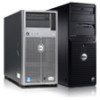Dell PowerEdge R420 Technical Guide - Page 29
Acoustical design - noise
 |
View all Dell PowerEdge R420 manuals
Add to My Manuals
Save this manual to your list of manuals |
Page 29 highlights
temperature sensors, including processors, hard disk drives, DIMMs, storage cards, and the inlet ambient temperature. Thermal control detects and responds to hardware configuration. Thermal management adjusts cooling according to what the system really needs, and draws lower fan power draw and generates lower acoustical noise levels than servers without such controls. • User-configurable settings: An R420 thermal control design target is to minimize the contribution of fan power to overall system power. However, with the understanding and realization that every customer has a unique set of circumstances or expectations of the system, in this generation of servers, we are introducing limited user- configurable settings in the iDRAC7 BIOS setup screen. For more information, see the Dell PowerEdge R420 Systems Owner's Manual on Support.Dell.com/Manuals and "Advanced Thermal Control: Optimizing across Environments and Power Goals" on Dell.com. • Fan fault tolerance: The R420 allows continuous operation with a motor failure in the system. The base configuration of the R420 has four fans. Additional fans are needed when using redundant power supplies and a second processor. The fault tolerance feature allows one motor fan to fail at a time allowing a fan replacement within 360 hours of a fan failure. • Environmental specifications: The optimized thermal management makes the R420 reliable under a wide range of operating environments as shown in the environmental specifications in Table 26. Many configurations are also compliant under expanded operating temperature environments, but a few are not. Acoustical design The acoustical design of the PowerEdge R420 reflects the following: • Versatility: The PowerEdge R420 saves you power draw in the data center, but it also is quiet enough for the office environment in typical and minimum configurations. Compare the values for LpA in Table 18 for these configurations, and note that they are lower than ambient measurements of typical office environments. • Adherence to Dell's high sound quality standards: Sound quality is different from sound power level and sound pressure level in that it describes how humans respond to annoyances in sound, like whistles and hums. One of the sound quality metrics in the Dell specification is prominence ratio of a tone, which is listed in Table 18. • Noise ramp and descent during bootup from power off: Fan speeds and noise levels ramp during the boot process (from power off to power on) in order to add a layer of protection for component cooling in the case that the system were not to boot properly. To keep bootup as quiet as possible, the fan speed reached during bootup is limited to about half of full speed. • Noise level dependencies: If acoustics is important to you, you may want to make the following configuration choices and settings for the PowerEdge R420 for quieter operation: - In the BIOS, select the power- optimized DAPC rather than performance- optimized for the system thermal profile - Turn hot spare feature off in PSU - Since hard drive noise is highly dependent on spindle speed, the 7200- rpm SATA hard drive will have the quietest hard drive operation However, some components cause significant but not necessarily intuitive increases in loudness when they are installed in the R420. Contributors to acoustical output can include: - More than one processor - PERC H710 mini, PERC H710P mini, or PERC H810 29 PowerEdge R420 Technical Guide















